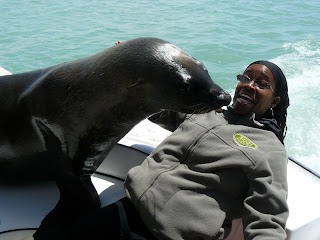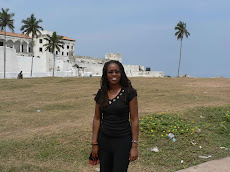
What is a road trip without a few hazards, right?!?!! Well…..I think I could have done without a few of these fateful occurrences. During the weekend, I decided to rent a car and drive to the coast with a friend visiting from the States. It was a long weekend, as Friday was a school holiday (Independence Day, though many places did not seem to show any special regard for the occasion), and I hadn’t yet seen that part of the country’s diverse landscape. Besides, I needed a serious break; my work has been incredibly rewarding, but incredibly demanding as well. So, “vacation” it was.
As I mentioned in an earlier post, Namibia’s roads are a combination of tarred and gravel. As I learned over the weekend, gravel roads are not all the same. There are some well-laid gravel roads and there are some areas with thousands of scattered rocks seemingly assembled to form a horizontal-like formation that tires can test if interested in a thrill. Unfortunately, it is not completely intuitive to tell which type of gravel road you are about to traverse simply from a map. There are definitely different types of paths – Main Routes, Minor Routes, Main Roads, Minor Roads – and also roads that are available ONLY to 4X4s. I thought I was good and informed, but I wouldn’t be taking the time to write this post if it were that simple.
We rented a 2WD Toyota Yaris (sedan) and decided to take C28, a number/code/designation that will stick in my mind for ages. Mind you, NO ONE suggested a route for me to take from Windhoek to Swakopmund (the coastal town communicated as my destination). I did, however, ask how long the trip should take. Four hours was the consistent response. I saw two possible routes, both were marked as open to “all traffic;” so, I decided to take the one that looked most direct. I’ll post a picture of the map and see what you think.
C28 was labeled a “minor route” and began as a tarred road but turned to gravel after about 50 km. The initial gravel was manageable, but then it turned tricky another 50 km down the way. There were big dips, turns, sand pools, and sometimes smooth points. Our speed had to be reduced considerably and it was clear that we would not be making it to Swakopmund in four hours. Little did I know at the time that we would not even make it that night!
I can easily say that I am glad and blessed that I had the companion of an excellent driver and a calm and collected responder to vehicular emergencies. Otherwise, I’d have been a bit …….. (you can fill in the blank any way you see appropriate once you finish the post). Ninety-nine percent of the cars in Namibia (included our rented Toyota Yaris) are manual, and I still need to re-learn how to drive stick, so he was on his own this trip. Anyway…...
Bottom-line(S): Stuck in sand in the Namib Desert and forced to sleep in the car overnight was not the memories I had in mind for this trip. Oh, and not to mention the decimated tire that luckily chose to reveal itself in the form of marijuana-smelling burnt rubber AFTER the pass (Bosua Pass to be exact) from hell.
OK - I’ll backup a bit.
What happened was, we were driving along, slowly, over plenty of tricky road. Once we realized that the route and road was shotty, it was too late to turn around and there were no easy opportunities to change to a smoother route.
The front passenger (left-side) tire was the first to go. The tire was crazy-destroyed by the time we smelled the burned rubber and stopped to investigate the culprit. THEN….we carried on and once we entered the Namib-Naukluft Park (IN THE NAMIB DESERT!), the car got super-stuck in the sand and we could not move on. At this time, the sun had set, our cell-phone service was virtually non-existent, and we hadn’t seen any cars or people for hours. My road-trip hero put on his fix-it gear and began trying to literally dig us out, but no luck. Every so often, I’d get one bar on my phone so I constantly had a text message waiting to be sent to the rental company’s 24-hour line. Ah, the rental company and the tour company that set me up with the rental company…..
OK, so it turns out that although we paid for a full damage waiver with the insurance we “chose,” the customer is ALWAYS responsible for tire and rim damage; SO, we had to pay for the burst tire and warped rim that met it’s fate against the gravel. (That was in the tiny print that I didn’t think to read that closely in the pre-rental phase).
Also, the rental company’s great 24-hour emergency line and support came with a yet undisclosed price. (Oh, we were “rescued” by a few people, including a driver from the rental company, at about 9:30am on Saturday. Mind you, we left for our 4-hour drive at about 3:00pm on Friday. We were stuck in the sand in the car, in the desert, alone, for about 12 hours, which is where we had to (try to) sleep.). Turns out that we were charged N$1238.00 for the road-side assistance. Yep, I was in for a civil fight. Couldn’t really fight about the tire and rim; should’ve put on granny’s glasses and read the policies written in 4-point font on the back of the contract; it’s there – section 8.0. BUT the road-side assistance charges and the way the tour company classified our problem got me unnerved.
The tour company director claimed that we were “negligent” for driving on C28; we should have known that driving on that road would damage the vehicle’s tires….. I can’t even go on with that knucklehead. Needless to say, tonight, at about 8:30pm, after meeting in-person with one of the managers of the rental car company, we settled on fees and liability issues that have taught me a few lessons, but that are manageable in light of the circumstances. I’ll follow-up later with the Namibia Roads Authority and with the Tourist Association to communicate my experiences, concerns, and suggestions.
Yes, I won’t forget this mini-adventure anytime soon (even with my trifling memory issues). I will say, though, that once we arrived in Swakopmund, cleaned-up, and rested on a real bed, we had a very nice time and I’ll write a post on a few of those activities next.
Could’ve been worse, so, I’m thankful……..
Oh yeah, we did get stuck in the sand one more time during the week, but luckily, there was a whole village of people waiting on the side of the road to push us out and then demand per person payment afterword. Joy! (Kinda makes you think they put the sand trap there intentionally……)















 What is a road trip without a few hazards, right?!?!! Well…..I think I could have done without a few of these fateful occurrences. During the weekend, I decided to rent a car and drive to the coast with a friend visiting from the States. It was a long weekend, as Friday was a school holiday (Independence Day, though many places did not seem to show any special regard for the occasion), and I hadn’t yet seen that part of the country’s diverse landscape. Besides, I needed a serious break; my work has been incredibly rewarding, but incredibly demanding as well. So, “vacation” it was.
What is a road trip without a few hazards, right?!?!! Well…..I think I could have done without a few of these fateful occurrences. During the weekend, I decided to rent a car and drive to the coast with a friend visiting from the States. It was a long weekend, as Friday was a school holiday (Independence Day, though many places did not seem to show any special regard for the occasion), and I hadn’t yet seen that part of the country’s diverse landscape. Besides, I needed a serious break; my work has been incredibly rewarding, but incredibly demanding as well. So, “vacation” it was.



